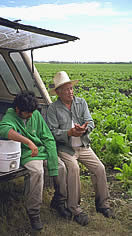

 Jean-Christophe Ammann--from "Siah Armajani" Kunsthalle Basel-Stedelijk Museum Amsterdam, 1987. |
![]() The
following guest essays provide ideas and insight into the issues and processes
of developing a public art initiative. The contributors share history,
tips and best practices gathered from their long, successful careers in
public arts programing and implementation. Their experience encompasses
university, city, and state level projects. These writings are designed
to give a deeper understanding into the complexities and layers of public
art by practitioners with diverse and varied expertise.
The
following guest essays provide ideas and insight into the issues and processes
of developing a public art initiative. The contributors share history,
tips and best practices gathered from their long, successful careers in
public arts programing and implementation. Their experience encompasses
university, city, and state level projects. These writings are designed
to give a deeper understanding into the complexities and layers of public
art by practitioners with diverse and varied expertise.
Regina M. Flanagan is a public art administrator, photographer and graduate landscape architect. She has seventeen years experience directing public art programs and projects, and has written numerous feature articles and opinion pieces for the Public Art Review. Recently, she authored the Public Art Framework and Field Guide for Madison, Wisconsin with The Placemaking Collaborative, Saint Paul, Minnesota. The public art featured with this essay was commissioned during Flanagan's tenure (1988-1998) as director of the Minnesota Percent for Art in Public Places program. Her essay provides a context for public arts projects and suggested approaches for successful implementation.
"Through the late nineteenth-century, public art was routinely part of American civic buildings and places. Using the models of ancient Greece and Rome, monuments as well as architectural ornament including carved friezes and statuary, depicted historic events and people. Principles like justice, liberty and equality were often abstractly personified in this art, which intended to portray America's civic values and ideals..."
> Public Art, Artist and Content
David Allen is a public art administrator currently managing public art installation and selection of the Minneapolis Hiawatha light-rail project. This light-rail corridor has several stations which will incorporate public arts projects with artists at many different stages of design and construction. Mr. Allen came to Minneapolis after a very successful 13 year term as the public arts administrator for San Jose, CA.
"There are currently over two hundred and fifty public art programs in existence in this country. The majority are structured after the "percent for art" model that originated in Philadelphia in the late 1950’s. However, there are numerous other funding and administrative formats employed by cities, counties, states, transit agencies, colleges, and universities.
The practice of public art and its administration is anything but a mutually accepted discipline with recognized standards. It is a very broad field that has evolved and expanded in a rather free-for-all manner. One of the benefits of this lack of structure is that it has lead to a continuing reinterpretation of how artists work in our built world. This work has been labeled, often in hindsight, with a number of descriptive terms: stand alone, art in public places, site specific, site responsive, site generated, integrated, community based, civic, art and design, and new genre. If nothing else, the sheer number of terms is evidence that a lot has gone on in this field, and more will come..."



